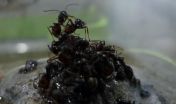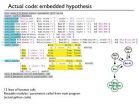(Press-News.org) When facing a flood, ants build rafts and use both the buoyancy of the brood and the recovery ability of workers to minimize injury or death, according to a study published in PLOS ONE on February 19, 2014 by Jessica Purcell from University of Lausanne, Switzerland, and colleagues. Furthermore, the queen ant is placed in the middle and protected on all sides by the rafting ants.
When put in harm's way, social animals are often able to work together to enhance the survival and welfare of the group. Ants living on flood plains are known to link to together to create rafts during floods, but less is known about the composition, shape, and social structure, if any, of these rafts. To better understand this process, scientists collected ants from a flood plain in Switzerland and brought them back to the lab so they could induce flooding in ant populations containing different combinations of worker ants, queens, and broods (containing developing larvae and pupae). During the 'flooding,' they observed where the workers, brood, and queens were positioned in the raft. The flooding also allowed them to observe the buoyancy and recovery ability of the worker ants and brood.
Researchers found that the worker ants and brood were extremely resistant to submersion. The workers protected the most vulnerable and valuable nest mate, the queen, by placing her in the center of the raft, and the worker ants used the buoyancy of the brood at the base and recovery ability of workers to create a raft and minimize ant injury or death. Both workers and brood exhibited high survival rates after they rafted, which suggests that occupying the base of the raft is not as deadly as scientists expected. Placing the brood at the base of the raft may also aid in keeping the nest together during the flood.
Dr. Purcell added, "We expected that individuals submerged on the base of the raft would face the highest cost, so we were astonished to see the ants systematically place the youngest colony members in that positions. Further experiments revealed that the brood are the most buoyant members of the society and that rafting does not decrease their survival; thus, this configuration benefits the group at minimal cost."
INFORMATION:
Citation: Purcell J, Avril A, Jaffuel G, Bates S, Chapuisat M (2014) Ant Brood Function as Life Preservers during Floods. PLOS ONE 9(2): e89211. doi:10.1371/journal.pone.0089211
Financial Disclosure: This work was supported by Swiss National Science Foundation grant 31003A_125306 (http://www.snf.ch/). The funders had no role in study design, data collection and analysis, decision to publish, or preparation of the manuscript.
Competing Interest Statement: The authors have declared that no competing interests exist.
PLEASE LINK TO THE SCIENTIFIC ARTICLE IN ONLINE VERSIONS OF YOUR REPORT (URL goes live after the embargo ends): http://dx.plos.org/10.1371/journal.pone.0089211
Ants build raft to escape flood, protect queen
Worker ants link bodies and buoyant broods to protect queen during flood
2014-02-20
ELSE PRESS RELEASES FROM THIS DATE:
Adding bevacizumab to initital glioblastoma treatment doesn't improve overall survival
2014-02-20
Glioblastoma (GBM) is the most common primary malignant adult brain tumor and, despite treatment advances in recent years, the average survival of patients enrolled in clinical trials is less than 16 months with few patients living beyond five years. GBM tumors are characterized by angiogenesis — the formation of new blood vessels that support tumor growth stimulated by the GBM-produced vascular endothelial growth factor A (VEGF-A). Bevacizumab is a monoclonal antibody that targets VEGF-A production to block the growth of tumor-derived blood vessels. "Clinical trials evaluating ...
Bevacizumab offers no benefit for newly diagnosed glioblastoma, MD Anderson-led study finds
2014-02-20
HOUSTON — The angiogenesis inhibitor bevacizumab (Avastin) failed to increase overall survival (OS) or statistically significant progression-free survival (PFS) for glioblastoma patients in the frontline setting, according to a study led by researchers at The University of Texas MD Anderson Cancer Center.
The study appears in the New England Journal of Medicine, and was first presented on the plenary session of the American Society of Clinical Oncology 2013 Annual Meeting by Mark Gilbert, M.D., professor in MD Anderson's Department of Neuro-Oncology.
Glioblastoma is ...
Bevacizumab (Avastin) fails to improve survival for newly diagnosed glioblastoma patients
2014-02-20
BALTIMORE – February 19, 2014. Adding bevacizumab (Avastin) to standard chemotherapy and radiation treatment does not improve survival for patients newly diagnosed with the often deadly brain cancer glioblastoma, researchers report in the Feb. 20 issue of the New England Journal of Medicine.
"We didn't see an improvement in overall survival or a statistically significant increase in progression-free survival, as defined in the context of this trial," says the study's senior author, Minesh P. Mehta, M.B., Ch.B., Professor of Radiation Oncology at the University of Maryland ...
SDSC team develops multi-scale simulation software for chemistry research
2014-02-20
Researchers at the San Diego Supercomputer Center at the University of California, San Diego, have developed software that greatly expands the types of multi-scale QM/MM (mixed quantum and molecular mechanical) simulations of complex chemical systems that scientists can use to design new drugs, better chemicals, or improved enzymes for biofuels production.
A paper outlining the research, titled 'An Extensible Interface for QM/MM Molecular Dynamics Simulations with AMBER' and conducted by members of the Walker Molecular Dynamics Lab (WMD) at SDSC, was featured on the cover ...
Clutter cutter
2014-02-19
WASHINGTON D.C. Feb. 19, 2014 -- Life can be messy at all scales, requiring different organizational strategies -- from cleaning the house, to removing damaged or expired cells from the body to avoid cancer progression.
In a messy house, people use computers to manage paper and photo clutter; companies use computer systems to track their inventory. Now a team of researchers at Vanderbilt University in Nashville, Tenn., is taking a similar approach to cell-molecular inventory control for cancer. They have created computer models, using their programming framework (PySB), ...
Does more stress equal more headaches?
2014-02-19
PHILADELPHIA – A new study provides evidence for what many people who experience headache have long suspected—having more stress in your life leads to more headaches. The study released today will be presented at the American Academy of Neurology's 66th Annual Meeting in Philadelphia, April 26 to May 3, 2014.
For the study, 5,159 people age 21 to 71 in the general population were surveyed about their stress levels and headaches four times a year for two years. Participants stated how many headaches they had per month and rated their stress level on a scale of zero to ...
Insurance status may influence transfer decisions in trauma cases, Stanford study reveals
2014-02-19
STANFORD, Calif. — Emergency rooms are less likely to transfer critically injured patients to trauma centers if they have health insurance, according to a new study by researchers at the Stanford University School of Medicine.
The counterintuitive finding suggests that insured patients are more at risk for receiving sub-optimal trauma care than uninsured patients are.
Although a majority of severely injured trauma patients are initially taken to trauma centers, at least one-third are taken to non-trauma centers. In these cases, emergency room doctors must assess the ...
HPV vaccination is associated with reduced risk of cervical lesions in Denmark
2014-02-19
A reduced risk of cervical lesions among Danish girls and women at the population level is associated with use of a quadrivalent HPV vaccine after only six years, according to a new study published February 19 in the Journal of the National Cancer Institute.
Two HPV vaccines are currently available and have proven to be highly effective against HPV16/18-associated cervical cancer. One of these vaccines, a quadrivalent vaccine, was licensed in Denmark in 2006, and it was subsequently incorporated into general childhood vaccination programs for girls free of charge and ...
Whole genome analysis, stat
2014-02-19
Although the time and cost of sequencing an entire human genome has plummeted, analyzing the resulting three billion base pairs of genetic information from a single genome can take many months.
In the journal Bioinformatics, however, a University of Chicago-based team—working with Beagle, one of the world's fastest supercomputers devoted to life sciences—reports that genome analysis can be radically accelerated. This computer, based at Argonne National Laboratory, is able to analyze 240 full genomes in about two days.
"This is a resource that can change patient management ...
Study shows in vivo endomicroscopy improves detection of Barrett's esophagus-related neoplasia
2014-02-19
DOWNERS GROVE, Ill. – February 19, 2014 – New research shows that the addition of confocal laser endomicroscopy to high-definition white-light endoscopy enables improved real-time endoscopic diagnosis of Barrett's esophagus dysplasia (neoplastic tissue) by using targeted biopsies of abnormal mucosa to reduce unnecessary mucosal biopsies and potentially reduce costs. It may also positively influence patient care by changing the plan for immediate endoscopic management. The study appears in the February issue of GIE: Gastrointestinal Endoscopy, the monthly peer-reviewed scientific ...
LAST 30 PRESS RELEASES:
COVID-19 leaves a lasting mark on the human brain
Scientists use ultrasound to soften and treat cancer tumors without damaging healthy tissue
Community swimming program for Black youth boosts skills, sense of belonging, study finds
Specific depressive symptoms in midlife linked to increased dementia risk
An ‘illuminating’ design sheds light on cholesterol
Who is more likely to get long COVID?
Study showcases resilience and rapid growth of “living rocks”
Naval Research Lab diver earns Office of Naval Research 2025 Sailor of the Year
New Mayo-led study establishes practical definition for rapidly progressive dementia
Fossil fuel industry’s “climate false solutions” reinforce its power and aggravate environmental injustice
Researchers reveal bias in a widely used measure of algorithm performance
Alcohol causes cancer. A study from IOCB Prague confirms damage to DNA and shows how cells defend against it
Hidden viruses in wastewater treatment may shape public health risks, study finds
Unlock the power of nature: how biomass can transform climate mitigation
Biochar reshapes hidden soil microbes that capture carbon dioxide in farmland
Reducing saturated fat intake shows mortality benefit, but only in high-risk individuals
Manta rays create mobile ecosystems, study finds
Study: Mixed results in using lipoic acid to treat progressive multiple sclerosis
Norbert Holtkamp appointed director of Fermi National Accelerator Laboratory
New agentic AI platform accelerates advanced optics design
Biologists discover neurons use physical signals — not electricity — to stabilize communication
Researchers discover that a hormone can access the brain by hitchhiking
University of Oklahoma researcher awarded funding to pursue AI-powered material design
Exploring how the visual system recovers following injury
Support for parents with infants at pediatric check-ups leads to better reading and math skills in elementary school
Kids’ behavioral health is a growing share of family health costs
Day & night: Cancer disrupts the brain’s natural rhythm
COVID-19 vaccination significantly reduces risk to pregnant women and baby
The role of vaccination in maternal and perinatal outcomes associated with COVID-19 in pregnancy
Mayo Clinic smartwatch system helps parents shorten and defuse children's severe tantrums early
[Press-News.org] Ants build raft to escape flood, protect queenWorker ants link bodies and buoyant broods to protect queen during flood


